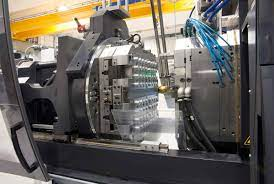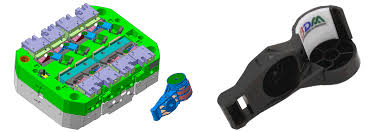
1. Injection Molding
With the injection molding method, we provide high-quality and multi-piece plastic parts and end product production services to our customers by using double injection mold. Injection molding is the most cost-effective way to mass-produce a plastic part.
2. Insert Molding
Insert molding is the process of injecting plastic onto a standard metal part placed in the mold to be injected and coated, making it a part of the final molded product. With this method, assembly is done without the need for assembly.
In this way, a more durable part is obtained compared to assembly processes.
3. 2K Over-molding
This molding method is the process of combining multiple materials using double injection mold into one piece at once. In this two-step process, the top of the hard plastic molded is then remold with a material, usually a thermoplastic elastomer.
With this method, you have both hard and rubbery components in the same part. Similarly, it is a very affordable way to make plastic parts perform better and look better.
4. Rotation Molding
This method is an ideal production method for creating hollow and large plastic parts that cannot be done with other injection methods. The raw material plastic is added to a mold that is slowly heated and rotated both vertically and horizontally.
Simultaneous heating and rotation distribute and fuses the plastic raw material to the inner surfaces of the double injection mold. In this method, the molds are relatively inexpensive in cost as they do not have to withstand the pressure.
Are plastic products produced by using double injection molds?
The plastic products produced are quite durable. Double-walled products is easy to print with rotational molding and foam easy to fill into the gap during or after production. Since the coloring agent adds to the plastic raw material, the products produced do not need to be painted.
Is Injection molding an economical method of plastic production?
Injection molding is the most economical production method for the mass production of plastic parts. The parts produced with this method suitable for automation do not require almost any post-processing. Moreover, material loss is very low.
This method offers a wide choice of materials and surface structures. In addition, production is easy to make with different raw materials with the same double injection mold. The mechanical strength of the parts is good since joining is generally not important for the removed parts.
What materials are common in double injection molds?
The range of plastic materials in production with the injection molding method is quite wide. With this method, many different types of plastic materials are easy to use as raw materials for different needs.
These different materials differ in their properties such as mechanical strength, chemical resistance, thermal resistance, appearance, cost, compatibility with food contact, and coefficient of friction.
Check out the material options!
The plastic material options we offer for production with the injection molding methods are as follows:
Usage areas
Injection Molding is is common in many industries such as
- Moreover, automotive,
- medical,
- Similarly, clothing,
- electronics,
- Furthermore, aerospace,
- rapid prototyping and the production of multi-part parts.
How the injection cylinder pushes the screw?
This time, the injection cylinder pushes the screw forward with a programmed speed and pressure.
The collar presses against the ferrule by escaping and, like a check valve, prevents the goods from escaping back. The goods pass through the nozzle and the runner and fill the double injection mold.
Ironing
A certain pressure presses the screw for a certain period of time in order to ensure that the part is in the desired dimensions and to prevent collapse and shrinkage in the mold during cooling.
At this stage, the plastic melt injected into the mold is ensured to fill the mold cavity by applying pressure. The duration of the process varies depending on the nature of the raw material is common, the size and weight of the pieces.
Mold Opening

When the mold is opened, the molded material is released from the female mold and there is no runner breakage. When the runner is empty, the goods in the nozzle do not automatically flow and block the runner or flow into the double injection mold.
While this process is taking place, the nozzle and the top of the bucket are heated in a controlled manner.
What are the molds? double injection molds
The mold is an essential part of injection molding. It brings the melted substance into the desired shape and cools it.
Molds are produced in a foundry. They are made of metal, usually steel or aluminum, and are precision-engineered so that they can develop the features of the desired molded part.
How many cavities double injection molds have?
Generally, a mold can have 1 to several hundred cavities. Similarly, the exact number depends on the size and complexity of the molded part desired.
Casting molds for production purposes are made of hardened steel. Moreover, the exact type of steel depends on the type of plastic for the casting, the surface processing of the molded part, and the casting temperature.
Which materials are is common in making prototypes?
Prototypes for casting double injection molds or casting molds for very small product quantities are often comeof aluminum or unhardened steel.
Professional companies works with selected foundries. Similarly, suppliers of a special mold must meet special selection criteria. Among other things, skills, prices and delivery times are important here. Furthermore, in order to obtain the optimal casting shape, which enables short cycle times and precise part geometry, our engineers work closely with the commissioned foundries.
What are the areas of application of double injection molds parts?
Injection molding processes are commonly is common to manufacture various molded parts. Similarly, the palette ranges from tiny components to entire vehicle body parts.
Advances in 3D printing, which uses photopolymers that do not melt during the injection molding of low-temperature thermoplastics, can be is common on simple molded parts.
Parts that are double injection mold must be precisely shape to simplify the injection molding process.
Final words:
The material for the molded part, the desired shape and features of the part, the material of the mold, and the properties of the injection molding machine must all be considered. The versatility of the injection molding process is favored by this breadth of considerations and possibilities.





